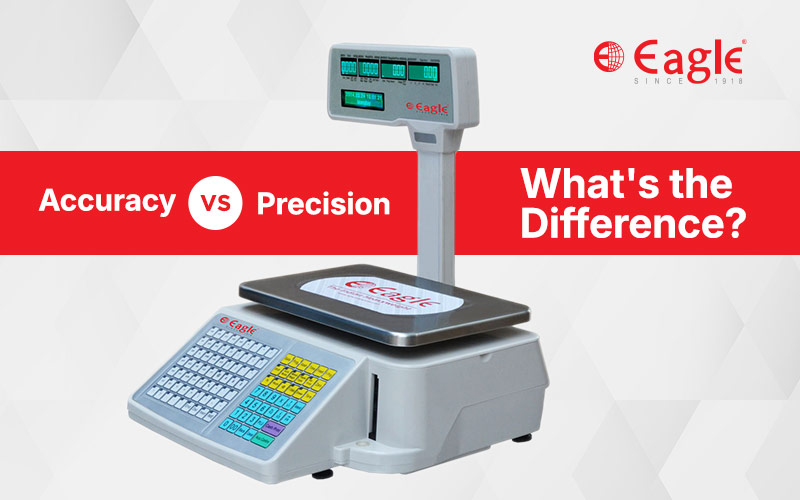When buying a weighing scale, the most important question to ask is how accurate and precise the device is. In everyday use, you can make do with instruments that are somewhat less accurate or precise. However, in industrial, pharmaceutical, or research applications, even the smallest errors in accuracy or precision can lead to drastically different results.
Now, you might have noticed that in the above section, accuracy and precision were mentioned side by side. This might give you the impression that these two terms are the same. However, despite common misconceptions and misuse, there is a big difference between the accuracy and precision of a scale.
This article delves into what makes accuracy and precision different and how they affect the reliability of personal or industrial weighing scales—so keep reading until the end.
- What is Accuracy?
- What is Precision?
- Accuracy Vs Precision: Some Examples to Help You Understand the Difference
- Accuracy Vs Precision: Key Differences
What is Accuracy?
Accuracy refers to how close a measured value is to the actual value of the quantity being measured. The ISO (International Organization for Standardization) also defines it as a value that is both close to true and consistent with the actual value.
Accuracy is a measure of how correct a given value is. It reflects the agreement between the measured result and the actual value. If both values are close, the measuring device is believed to be highly reliable.
A highly accurate measurement is largely free from systematic errors, i.e., errors caused by faulty measuring instruments, flawed experimental designs, or human negligence, as well as random errors, i.e., unpredictable errors that do not have a consistent pattern. These errors are caused by physical conditions or the inherent limitations of the weighing scale.
Accuracy shows you how well the measuring scale is working and whether you can use it to get reliable data, based on which you have to make decisions to guide your operations.

What is Precision?
Accuracy tells you about how close measured values are to the real value, but precision shows you how close the measured values are to each other. In other words, it refers to the reproducibility of the measurements under the same working conditions.
Precision has nothing to do with how close the value is to the true value; instead, it has more to do with the degree to which measured values yield the same results. Precision, thus, deals with the consistency of measurements by showing you how much each measured value varies from the other in the same conditions.
Precision alone is not a very good indicator of the reliability of industrial or personal scales. A scale can be highly precise (producing consistent results) while also being inaccurate at the same time.
Precision mainly deals with the following two concepts:
- Reproducibility
Reproducibility tells you about how close the measurements are to each other under different external conditions, like changes in measurement methods, instruments, surroundings, or the observer.
- Repeatability
Repeatability tells you about how close the measured values are to each other under the same conditions. A device or a measurement method has high repeatability if it yields similar results when the same procedure, measuring device, the same observer, and external conditions are used to take measurements.

Accuracy Vs Precision: Some Examples to Help You Understand the Difference
There are a few examples that you can consider to understand the difference between accuracy and precision.
Example 1
Let’s say you want to measure a 25 Kg bag of flour. With one instrument, you get a value of 24.9 Kg while another gives you a value of 25.7 Kg. The former instrument is more accurate as it gives you a value that is closer to the actual value.
Now, let’s say you have several 25 Kg bags of flour and you weigh them all using a scale. Every time, the scale gives you a reading of 25.4Kg, 25.5Kg, 25.6Kg, etc. This indicates that the instrument is highly precise but not very accurate, as the values are close to each other but not to the actual value.
Example 2
Let’s take another example. Consider a player playing basketball. If the player makes the basket every single time despite hitting different portions of the rim, they have a high degree of accuracy.
On the other hand, if the player doesn’t make the basket but consistently hits the same part of the rim, she has a high degree of precision.
And finally, if a player always hits the same part of the rim and always makes the basket, she will be both precise and accurate.
Example 3
Let’s take another popular example. Consider you are playing darts and your darts land near the bull’s eye (true value) almost every time. However, there are a few times when the darts miss and they scatter on the board. In this case, you are highly accurate but less precise.
Now, another guy comes and hits the same part of the dart board every single time, but not the center. This person is more precise but not accurate.
Another guy comes, and he hits the center part of the dartboard every single time. This person is both highly accurate and precise, which is what every measurement ideally should be.
And finally, if a person shoots the darts and hits a different point every single time and there are no clear patterns, he is neither accurate nor precise.
Accuracy Vs Precision: Key Differences
The following are the major differences between the accuracy and precision of weighing solutions to clarify this for you.
| Accuracy | Precision |
| Accuracy gives you the measure of agreement between the measured and the real value. | It tells you how close measured values are to each other under similar conditions. |
| A single measurement is needed to determine the accuracy of a device. | Multiple measurements are required to determine the precision of a device. |
| It measures the correctness of a device or method. | It measures consistency, repeatability, or reproducibility. |
| It is affected by systematic and random errors. | It is mainly affected by random errors. |
| It can be calculated by comparing the measured value to the known reference value. | Standard deviation or variance concepts are used to quantify precision. |
| A scale is accurate if it shows a correct or close-to-correct weight. | A scale is precise if it gives you measured values that are close to each other for similar weights under similar conditions. |
Conclusion
Both accuracy and precision are very important in a weighing scale as they determine how accurate and reliable the readings actually are. Accuracy deals with the closeness of measured values to the real value, while precision tells you how close different values are to each other.
An ideal weighing scale should be both accurate and precise under all conditions. To ensure the accuracy and precision of your weighing scale, you need to buy quality products that have high sensitivity and range, perform regular calibrations to align the instrument with a known standard, and use accurate handling methods.
This will ensure that every measured value is both accurate and consistent, leading to much better operational efficiency and productivity in all settings.
Visit us at Eagle Scales today to explore our wide range of highly accurate and precise personal, commercial, and industrial weighing scales to get the best value for your money.






